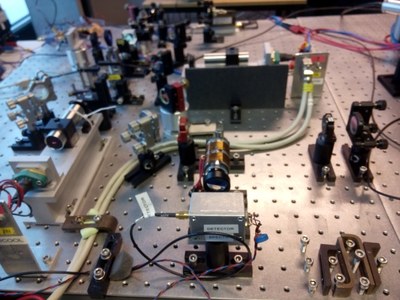F-Praktikum: Laser spectroscopy (English)

Are you interested in working with us? Check our webpage!
https://www.physics.hu-berlin.de/en/qom/positions
Supervisor
- Dr. Sana Amairi Pyka
- spyka(at)physik.hu-berlin.de
- Raum NEW15 1'613
Execution
The experiment takes one day in the laboratory. The evaluation can then be made independently.
The lab is located in NEW15 2'107. Before the start of the experiment, usually at 10am, the students are asked to meet with the supervisor in room NEW15 1'613.
Please bring a USB stick for data recording and your laptop to verify that the data is well saved. Please notice that this experiment will be held in English.
Theme
Spectroscopy is a diverse scientific branch that serves not only to determine the composition of molecules and gases, but also to study atomic energy levels. This allows scientist to know the energy value, and thus the laser frequency, required to shift one atom from one atomic eigenstate to another. An accurately defined atonic transition is crucial for many research fields of fundamental physics. In our days, ultra-stable lasers used in optical frequency standards are mainly locked to a well-defined narrow atomic transition. They are also used in the generation and manipulation of ultra-cold atoms, quantum information processing and the production of the Bose-Einstein condensate.
In order to stabilize a laser to a specific atomic transition, a spectrum is first required that makes these transitions visible with the greatest possible accuracy.
In this experiment, different transmission spectra of rubidium atoms inside a rubidium gas cell are to be recorded using a diode laser. The frequency values in the atomic spectrum are to be defined and the spectrum analysed using the literature values of the hyperfine transitions.
Materials
Please read the following texts beforehand:
- Instruction manual (Versuchsanleitung)(PDF)
- Demtröder, W. (2010): Experimentalphysik 3 - Atome, Moleküle und Festkörper, 4. Auflage, Springer-Verlag (Abschnitt 10.1, Spektroskopische Verfahren, speziell 10.2.7, Sättigungsspektroskopie)
- Demtröder, W. (2011): Laserspektroskopie 1 - Grundlagen, 6. Auflage, Springer-Verlag (Abschnitt 3.2, Doppler-Verbreiterung und Abschnitt 5.6.1, Halbleiterlaser)
Optional:
- Bjorklund, G.C. et al. (1983): Frequency Modulation (FM) Spectroscopy - Theory of Lineshapes and Signal-to-Noise Analysis, Applied Physics B
- Wieman, C.E. and Hollberg, L. (1990): Using diode lasers for atomic physics, University of Colorado & National Institute of Standards and Technology
- Steck, D. A. (2010): Rubidium 87 D Line Data (PDF)
Protocol
The protocol should not be longer than 10 pages and should be given no later than two weeks after the experiment. There is no objection to electronic submissions by e-mail if the protocol is in PDF format!
The protocol should also be used as a preparation for scientific publications, eg Bachelor thesis. Accordingly, an appropriate form of the protocol must be chosen.
In addition to the main part, which contains a sketch of the experimental setup and a presentation of the experimental results via scientific plots and evaluations, the protocol should contain an abstract (including the most important results), a brief introduction and a summary.
